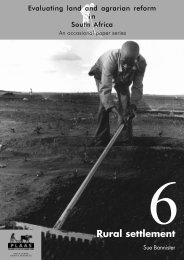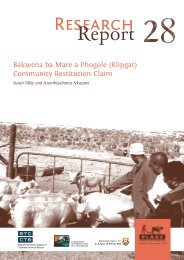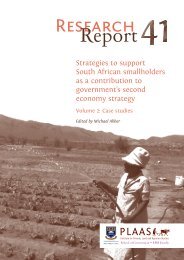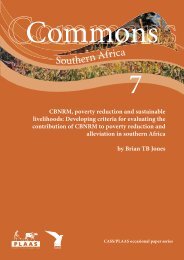A critical appraisal of South Africa's market-based land reform policy
A critical appraisal of South Africa's market-based land reform policy
A critical appraisal of South Africa's market-based land reform policy
You also want an ePaper? Increase the reach of your titles
YUMPU automatically turns print PDFs into web optimized ePapers that Google loves.
A <strong>critical</strong> <strong>appraisal</strong> <strong>of</strong> <strong>South</strong> Africa’s<br />
<strong>market</strong>-<strong>based</strong> <strong>land</strong> <strong>reform</strong> <strong>policy</strong><br />
that was not under <strong>land</strong> claim, and the<br />
current lessees were approached to<br />
establish if they qualified for LRAD grants<br />
and wanted to participate in the programme.<br />
In all cases they qualified and<br />
became LRAD beneficiaries for the<br />
purpose <strong>of</strong> purchasing the <strong>land</strong> they were<br />
leasing (interview 32).<br />
The state <strong>land</strong> acquired by LRAD<br />
beneficiaries in this manner is all adjacent<br />
to former home<strong>land</strong> areas. It was bought<br />
by the apartheid regime and held by the<br />
<strong>South</strong> African Development Trust (SADT)<br />
for incorporation into those home<strong>land</strong>s.<br />
The process <strong>of</strong> transferring the <strong>land</strong> into<br />
the home<strong>land</strong>s was not done; instead it was<br />
leased to farmers. The White Paper<br />
identifies former SADT <strong>land</strong> as available<br />
for redistribution and requires it, along<br />
with other public <strong>land</strong>, to be used to<br />
support ‘government’s macro economic,<br />
human development and redistribution<br />
goals’. It also calls for the establishment <strong>of</strong><br />
‘acceptable mechanisms for public<br />
consultation on the use <strong>of</strong> state and public<br />
<strong>land</strong>’ (DLA 1997:83–4). The LRAD <strong>policy</strong><br />
envisages that the programme could be<br />
used for the disposal <strong>of</strong> agricultural<br />
state <strong>land</strong>. It also calls for a public<br />
announcement <strong>of</strong> intent to sell the state<br />
<strong>land</strong> and suggests a three-month notice<br />
period to give an opportunity for beneficiaries<br />
to organise themselves to make<br />
bids for the <strong>land</strong> (DLA 2001:12; NDA<br />
2001:9).<br />
The LRAD <strong>policy</strong> requires proposals to<br />
include the ‘value <strong>of</strong> the <strong>land</strong> relative to<br />
<strong>market</strong> prices’ and makes no mention <strong>of</strong> a<br />
different approach for the valuation <strong>of</strong><br />
state <strong>land</strong> (DLA 2001:11). However the<br />
decision taken for the LRAD programme<br />
in Limpopo to value the state <strong>land</strong> at<br />
production values is in line with the DLA<br />
Handbook on property valuation. The<br />
handbook states that the general <strong>policy</strong> is<br />
‘to estimate fair <strong>market</strong> value’, but goes on<br />
to say that where state <strong>land</strong> is to be<br />
disposed <strong>of</strong> for redistribution projects ‘the<br />
preferred valuation approach is to estimate<br />
the productive value <strong>of</strong> the property’ (DLA<br />
2000:2, 19).<br />
Implementers’ perceptions<br />
All the <strong>of</strong>ficials interviewed believed that<br />
the implementation <strong>of</strong> LRAD was going<br />
slowly in Limpopo, although one felt that<br />
it was better than a number <strong>of</strong> other<br />
provinces (interview 1). The main reasons<br />
suggested for the slow pace <strong>of</strong> delivery<br />
are the high prices being demanded by<br />
<strong>land</strong>owners, the slow process <strong>of</strong> buying<br />
<strong>land</strong> by the government with all the<br />
information and stages <strong>of</strong> approval that<br />
are required, and the amount <strong>of</strong> <strong>land</strong> under<br />
restitution claims.<br />
There were differing opinions on the<br />
extent <strong>of</strong> involvement <strong>of</strong> women in<br />
projects, and <strong>of</strong>ficials did not seem to have<br />
access to, or were not aware <strong>of</strong>, any<br />
figures showing how many women were<br />
involved and how much <strong>land</strong> they had<br />
obtained. Where women are involved in<br />
decision making, <strong>of</strong>ficials remain concerned<br />
that they <strong>of</strong>ten remain passive and<br />
‘rubber stamp’ decisions. One reason<br />
given for a lack <strong>of</strong> women’s involvement<br />
was that ‘women want <strong>land</strong> close to where<br />
they live’ (interview 4). Given the lack <strong>of</strong><br />
access to transport for most rural women<br />
and judging by the long distances that<br />
many beneficiaries have to travel to the<br />
<strong>land</strong> acquired, this could be a significant<br />
factor which is not considered in LRAD<br />
project design (see Chapter 7). It was<br />
commonly agreed that further efforts need<br />
to be made to ensure that women get<br />
actively involved and benefit from the<br />
redistribution programme.<br />
Estimates for the time taken to process<br />
applications from the initial application to<br />
project approval ranged from 2–6 months<br />
(interview 1) and a minimum <strong>of</strong> six<br />
months (interview 2). Factors identified as<br />
causing delays were: delays in getting<br />
valuation reports; farmers refusing to sell<br />
or delaying the sales; the general delays<br />
from government due to its protocols and<br />
procedures (it was noted that the DLA is<br />
revising the project cycle to try and<br />
shorten it); and problems in the committees<br />
dealing with project approvals, because<br />
they were initially not sure how to handle<br />
applications.<br />
26
















